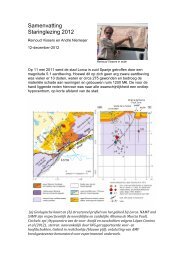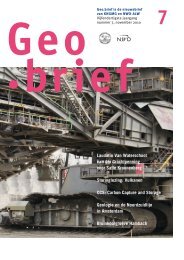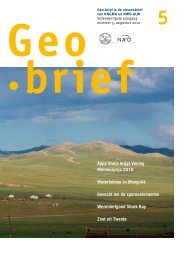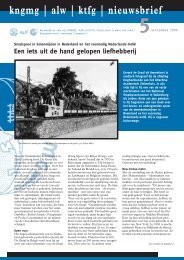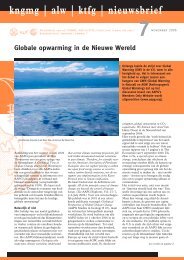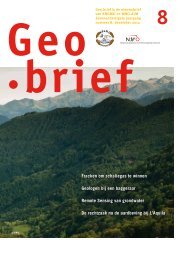Create successful ePaper yourself
Turn your PDF publications into a flip-book with our unique Google optimized e-Paper software.
.historie<br />
A message from Holland<br />
Oud-voorzitter van het KNGMG, Peter de Ruiter, schreef ter ere van de 50ste verjaardag van het IAGI (Ikatan<br />
Ahli Geologi Indonesia, de geologische dienst van Indonesië) een brief namens het huidige bestuur van het<br />
Genootschap met daarin de hartelijke felicitaties en de beste wensen voor de toekomst. Naast de brief schreef<br />
hij een artikel over de geschiedenis van de geologie van Indonesië. Onderstaand een iets ingekorte versie.<br />
The pre-history<br />
The story of the Dutch–Indonesia connection<br />
starts more than 400 years ago,<br />
when (in 1595) four Dutch ships sailed<br />
to the East via a secret route that was<br />
spied from the Portuguese. They arrived<br />
fifteen months later in Bantam and<br />
returned to Amsterdam in 1597 with only<br />
three ships and one third of the men.<br />
The VOC was created, dominating the<br />
history of the Dutch–Indian relations<br />
completely until its bankruptcy in 1796.<br />
In 1795 the French conquered the<br />
Netherlands, and a French-friendly<br />
Dutchman (Daendels) was sent to govern<br />
Indië (1807–1810). He had the Jalan<br />
raya pos constructed, the 1000 km long<br />
post road on Java, running from Anyer to<br />
Panarukan, that has cost thousands of<br />
lives. After the French, the Brits came<br />
and Sir Thomas Raffles ruled from 1811<br />
until 1816. Thereafter protracted negotiations<br />
took place, resulting in England<br />
and the Netherlands agreeing on the<br />
distribution of their previous interests.<br />
The Dutch, pretty sharp negotiators in<br />
those days, ended up with the entire<br />
area that now comprises the Republik<br />
Indonesia. Through today’s eyes it is<br />
almost surrealistic to read how European<br />
nations agreed, after long and tedious<br />
negotiations, on the distribution amongst<br />
themselves of Asian territories that were<br />
not even theirs!<br />
Now the Indies were a colony, which<br />
implied that the Netherlands made themselves<br />
responsible to rule, defend and<br />
develop an immensely large part of the<br />
globe, measuring, sea included, some<br />
8 million km 2 , about 200 times the<br />
14 Geo.brief december 2010<br />
Netherlands. The land area is distributed<br />
over thousands of islands, with many religions,<br />
traditions, races, languages and<br />
social structures. The Netherlands was,<br />
at that time, a small country with some<br />
3 million people, totally impoverished by<br />
the French occupation and only a few<br />
years away from a brief but costly conflict<br />
when in 1830 today’s Belgium decided<br />
to claim independence from Holland.<br />
The history<br />
In 1848 the Netherlands became a<br />
constitutional monarchy with most power<br />
for the democratically chosen parliament.<br />
‘Our’ Indian territories became a controversial<br />
political issue. In 1848, the governing<br />
body in Indië discussed the usefulness<br />
of mining engineers to investigate<br />
the mineral riches of the archipelago.<br />
The thought was that six engineers could<br />
do the job. They were to be educated at<br />
the Academy in Delft and should spend,<br />
for training purposes, at least two years<br />
in active mining areas in the UK or in<br />
Germany. On the 3rd of July 1850, the<br />
first mining engineer, Cornelis de Groot,<br />
arrived in Batavia, the present Jakarta,<br />
soon followed by engineers Schreuder,<br />
Liebert and Huguenin. The colonial<br />
administration first feared that more than<br />
six engineers could lead to unemployment,<br />
but later the target was shifted to<br />
fifteen. They worked for ‘Het Mijnwezen’,<br />
which became part of the ‘Ministerie<br />
van Onderwijs, Justitie en Industrie’.<br />
Gradually the Government realised what a<br />
monstrously big task it was to investigate<br />
the geology and the mineral potential<br />
of this large country, but the number<br />
of fifteen was adhered to until 1900.<br />
Several (up to eight) engineers were<br />
assigned to the Tin mines of Banka.<br />
Banka tin mining started already in 1710<br />
and was then managed by the VOC. When<br />
the State took over and found Banka to<br />
be the only source of easy income to support<br />
the ailing motherland, obviously this<br />
got priority, but it was at the cost of many<br />
engineers that could otherwise have done<br />
the highly needed geological investigations<br />
in the archipelago. (The Billiton<br />
tin venture was from the start (1852) a<br />
private enterprise outside the influence<br />
of the state-controlled Bureau of Mines).<br />
Too few general geological studies were<br />
done until 1910. The mining engineers<br />
were rather sent on a mineral chase,<br />
like coal, tin, gold, copper. This led to a<br />
complaint by N. Wing Easton who, back<br />
from an unsuccessful campaign in West<br />
Borneo (the present Kalimantan) sighed:<br />
“the area is poor in minerals, coal, oil,<br />
or gold... The causes for that are obvious<br />
and if we had given priority to geological<br />
mapping over mining investigations, we<br />
would have spared ourselves a lot of<br />
money and frustration” (1904).<br />
An exception was R.D.M. Verbeek, the<br />
most important geologist of the first<br />
decennia after 1850, and author of<br />
the book ‘Geologische verkenningen<br />
van Java’. He liked basic geological<br />
mapping and was in fact scared of finding<br />
possible useful deposits, like coal<br />
or gold, as that would distract him from<br />
his real objectives.<br />
A change of attitude took place around<br />
the turn of the century and this translated



